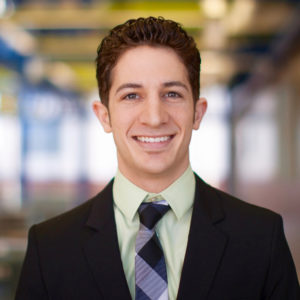sponsored content
October 1, 2021
By Brett O’Connor, OD, FAAO
There’s no one right way to have these discussions with patients. However, no matter how you approach these conversations, I strongly emphasize the importance of keeping it simple.
 A lot of practitioners are excited to embrace the growing field of myopia management, but as with all new technology in eye care, one of the most important pieces of the puzzle is how to present it to our patients in a clear and concise way. We’re all very familiar with myopia, but success in myopia management requires practitioners to look at myopia a little bit differently.
A lot of practitioners are excited to embrace the growing field of myopia management, but as with all new technology in eye care, one of the most important pieces of the puzzle is how to present it to our patients in a clear and concise way. We’re all very familiar with myopia, but success in myopia management requires practitioners to look at myopia a little bit differently.
As eye care professionals, how do we best go about explaining to parents why myopia management treatment is so important? Simplicity is key.
Master the Myopia Talk
There’s no one right way to have these discussions with patients. What resonates with one family may not resonate with another. What makes sense in my practice may not always make sense in yours. However, no matter how you approach these conversations, I strongly emphasize the importance of keeping it simple.
One of the first steps is getting buy-in from parents to pursue some form of myopia management. I always like to keep things upbeat and avoid using scientific terms when possible. I try to make myopia management seem new and exciting, rather than scary – or worse, boring. Try not to get discouraged. No matter how many times you have this conversation or how good you get at it, you’re going to have parents and families who just aren’t interested. Sometimes you can think of it as planting the seed for next year.
It’s also important to identify patients who are ideal candidates for myopia management. Any myopia is going to indicate some kind of future progression. For me, that means that any young myope is a candidate for myopia management. I find that children between 8 and 12 make great candidates, although I have a lot of patients outside of that range. The important thing is not to waste time waiting for children to reach a certain myopia threshold or a certain progression threshold, because that’s just wasting time. We know that children generally progress the fastest at the earliest years after the onset of myopia. The more often you have these discussions with families, the more comfortable you’re going to become. The more comfortable you are, the more success you’ll have.
What Parents Need to Understand
I find that nearly every parent understands myopia management after this discussion, but I do my best to keep things as simple as possible. After this, most don’t require or even want any more details. First, we’ll explain that myopia progression has increased. I tell them the good news: their child’s eyes are healthy, but the myopia, or nearsightedness, has increased. Then, I explain the reason why myopia has increased, which is because as the child is growing taller, the child’s eyes are growing longer, and at this point, the eyes are growing at too fast a rate. Once everyone acknowledges and understands this, we’ll explain that this elongation of the eye puts stress on the eye, which increases the risk for problems. I like to emphasize at this point that even though these changes are going on in childhood, which are going to increase those risks, they generally manifest in adulthood. This helps reduce the likelihood of anyone becoming scared or overwhelmed during this conversation. Once the parents understand this, the last point is simple: we have safe, effective ways to slow eye growth, and I’d like for us to pursue one of these options starting today.
What Parents Don’t Need to Understand
We can sometimes be our own worst enemy when it comes to this discussion. We’re so excited to discuss all the science and theory that we just learned in a great CE class that we end up overloading parents with information. This almost always backfires and leaves parents thinking that this is just too much to process. Parents often don’t even ask how soft multifocal contact lenses work or the mechanism behind orthokeratology or low-dose atropine. They’re trusting that you understand it, so you don’t want to overload them with information that they don’t need or even want. I try to avoid the following bits of information: every detail about every treatment option, differences between ATOM and LAMP2 studies, how optical profiles of various multifocal lenses differ, peripheral hyperopia theory, the role of accommodation in myopia progression, theories behind mechanism of action of atropine therapy.
Discussion of Treatments
This is going to depend on your patients, practice, and your goals for your myopia management clinic. Some practices will push OrthoK very heavily, and in that case, your discussion may be different from mine. In all cases, remember the importance of simplicity. Parents will ask: If this was your child, what treatment would you choose? Or: which treatment option do you think is the best? It’s important to make a recommendation that’s based on your exam, your comfort level, and the individual patient. I find that soft multifocal lenses, such as VTI’s NaturalVue contact lenses, are often the most intuitive option for families, as many of them haven’t heard of OrthoK or they may have a harder time understanding the need for long-term eyedrops when there’s no problem with the eye.
However, practitioners should also be prepared for parents worrying their child isn’t old enough for contacts. While getting to know the child during the exam, this is the time to rule out any patients who shouldn’t be put into contact lenses. Not every child is mature enough to handle that kind of responsibility, and that’s why it’s important to present every option to parents and get an idea of the child’s maturity. Not every patient is the right candidate for every treatment.
Preparing for the Follow-Up Exam
We educated the parent on proactive myopia management. We talked about treatments and picked one. Now we’re at our six-month follow-up visit to see how the child is doing. What do we talk about? You guessed it: keep it simple. I give the patient and the parent a brief reminder of what we’re doing and why we’re doing it and try to keep their excitement up. Remember, we’re not making myopia control about stopping myopia progression, because we can’t really predict that we’ll do that. Technically we have no way of knowing what the patient’s eyes would have done if we had not initiated myopia management. These visits are about checking in with the patient, making sure they’re doing well, and providing encouragement, rather than worrying about the change and emphasizing how big or small of a change it was. The goal is to make sure that parents and patients understand the benefits associated with continuing treatment; we don’t want them to be discouraged if myopia progression slowed by just -0.25D.
Keep it Simple
What’s the best thing to remember when talking with parents about myopia management at any point in the process? Keep it simple. We know that offering our patients myopia management treatments is such an important opportunity to make a difference, and we want to be able to feel as calm, comfortable, and prepared as possible each and every time.
For more on how to talk to parents about myopia management, watch this VTI video from Brett O’Connor, OD, FAAO, here.

Brett O’Connor, OD, FAAO, is an optometrist with MyEyeDr. in Jacksonville, Fla. He graduated with honors from Southern College of Optometry in 2016. This article is sponsored by Visioneering Technologies, Inc. (VTI). Dr. O’Connor is a member of the VTI Speakers’ Bureau.
MKT-NVM-AP59













